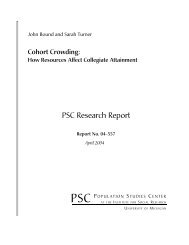Population Ageing and the Well-Being of Older Persons in Thailand ...
Population Ageing and the Well-Being of Older Persons in Thailand ...
Population Ageing and the Well-Being of Older Persons in Thailand ...
You also want an ePaper? Increase the reach of your titles
YUMPU automatically turns print PDFs into web optimized ePapers that Google loves.
Section 3: Demographic, Social <strong>and</strong> Economic Pr<strong>of</strong>ile<br />
<strong>of</strong> urban elderly. The higher proportion <strong>of</strong> rural<br />
elderly still work<strong>in</strong>g likely reflects a greater tendency<br />
<strong>in</strong> agriculture compared to work <strong>in</strong> <strong>the</strong> formal sector<br />
to reduce work ra<strong>the</strong>r switch from a situation <strong>of</strong> full<br />
activity to no activity. An additional contribut<strong>in</strong>g<br />
factor is likely an absence <strong>of</strong> externally imposed<br />
retirement ages for persons <strong>in</strong> agriculture, most <strong>of</strong><br />
whom are self employed. Among those who did work<br />
dur<strong>in</strong>g <strong>the</strong> prior week, just over half (52 per cent) <strong>of</strong><br />
<strong>the</strong> women <strong>and</strong> 61 per cent <strong>of</strong> <strong>the</strong> men were active <strong>in</strong><br />
agriculture (<strong>in</strong>clud<strong>in</strong>g fish<strong>in</strong>g). Moreover, accord<strong>in</strong>g<br />
to <strong>the</strong> first round <strong>of</strong> <strong>the</strong> 2007 Labor Force Survey,<br />
agricultural pursuits are far more common among<br />
older age workers than among economically active<br />
persons at younger ages. For example, engagement <strong>in</strong><br />
agriculture among workers under age 50 is only<br />
modestly more than half <strong>the</strong> level found for workers<br />
age 60 <strong>and</strong> older.<br />
Sources <strong>of</strong> <strong>in</strong>come. Although important, work is but<br />
one <strong>of</strong> a number <strong>of</strong> possible sources <strong>of</strong> <strong>in</strong>come for<br />
older aged Thais as Table 3.4 <strong>in</strong>dicates. Among all<br />
persons age 60 <strong>and</strong> above, by far <strong>the</strong> most common<br />
source <strong>of</strong> <strong>in</strong>come are <strong>the</strong>ir children. Over 80 per cent<br />
<strong>in</strong> 2007 reported at least some <strong>in</strong>come from children<br />
dur<strong>in</strong>g <strong>the</strong> prior 12 months. One’s own work is <strong>the</strong><br />
second most reported source although less than 40<br />
per cent overall report such <strong>in</strong>come <strong>and</strong> thus appears<br />
to be a far less common source than children. To<br />
some extent, <strong>the</strong>se results likely understate <strong>the</strong> extent<br />
that work contributes to older persons <strong>in</strong>come. This<br />
is so because presumably responses refer to <strong>the</strong><br />
respondent’s own work <strong>and</strong> do not take account <strong>of</strong><br />
<strong>in</strong>come from <strong>the</strong>ir spouse’s work which married<br />
couples are likely put to mutual use. Indeed, almost a<br />
fourth <strong>of</strong> respondents cite <strong>the</strong>ir spouse as a source <strong>of</strong><br />
<strong>in</strong>come. This category presumably <strong>in</strong>cludes all<br />
contributions from <strong>the</strong> spouse <strong>in</strong>clud<strong>in</strong>g ones<br />
result<strong>in</strong>g from economic activity. Almost a third <strong>of</strong><br />
respondents report some <strong>in</strong>come from <strong>in</strong>terest,<br />
sav<strong>in</strong>gs or rent <strong>and</strong> almost a fourth report receipt <strong>of</strong><br />
government elderly welfare allowances, a noteworthy<br />
<strong>in</strong>crease from <strong>the</strong> five per cent who reported such<br />
allowances earlier <strong>in</strong> <strong>the</strong> 2002 round <strong>of</strong> <strong>the</strong> survey<br />
(Knodel et al. 2005). Income from relatives is<br />
considerably less common <strong>and</strong> pensions are reported<br />
by only five per cent <strong>of</strong> all older persons.<br />
The per cent <strong>of</strong> older persons report<strong>in</strong>g particular<br />
sources <strong>of</strong> <strong>in</strong>come varies with age, gender <strong>and</strong> area <strong>of</strong><br />
residence. Consistent with <strong>the</strong> decl<strong>in</strong>e <strong>in</strong> economic<br />
activity with age discussed above, persons age 70 <strong>and</strong><br />
over are far less likely to report work as a source <strong>of</strong><br />
<strong>in</strong>come than those <strong>in</strong> <strong>the</strong>ir sixties. The decl<strong>in</strong>e <strong>in</strong><br />
economic activity with age, toge<strong>the</strong>r with <strong>in</strong>creases <strong>in</strong><br />
widowhood, likely accounts for <strong>the</strong> lower percentages<br />
21















